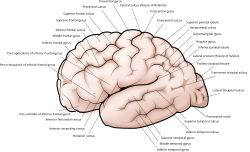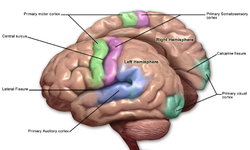
Back قشرة مخية Arabic Corteya cerebral AST بئیین کورتکسی AZB Кара вялікіх паўшар’яў Byelorussian Мозъчна кора Bulgarian Moždana kora BS Escorça cerebral Catalan توێکڵی مێشک CKB Mozková kůra Czech Hjernebark Danish
| Cerebral cortex | |
|---|---|
 | |
 Motor and sensory areas of the cerebral cortex | |
| Details | |
| Part of | Cerebrum |
| Identifiers | |
| Latin | cortex cerebri |
| MeSH | D002540 |
| NeuroNames | 39 |
| NeuroLex ID | birnlex_1494 |
| TA98 | A14.1.09.003 A14.1.09.301 |
| TA2 | 5527, 5528 |
| FMA | 61830 |
| Anatomical terms of neuroanatomy | |
The cerebral cortex, also known as the cerebral mantle,[1] is the outer layer of neural tissue of the cerebrum of the brain in humans and other mammals. It is the largest site of neural integration in the central nervous system,[2] and plays a key role in attention, perception, awareness, thought, memory, language, and consciousness. The cerebral cortex is the part of the brain responsible for cognition.
The six-layered neocortex makes up approximately 90% of the cortex, with the allocortex making up the remainder.[3] The cortex is divided into left and right parts by the longitudinal fissure, which separates the two cerebral hemispheres that are joined beneath the cortex by the corpus callosum. In most mammals, apart from small mammals that have small brains, the cerebral cortex is folded, providing a greater surface area in the confined volume of the cranium. Apart from minimising brain and cranial volume, cortical folding is crucial for the brain circuitry and its functional organisation.[4] In mammals with small brains, there is no folding and the cortex is smooth.[5][6]
A fold or ridge in the cortex is termed a gyrus (plural gyri) and a groove is termed a sulcus (plural sulci). These surface convolutions appear during fetal development and continue to mature after birth through the process of gyrification. In the human brain, the majority of the cerebral cortex is not visible from the outside, but buried in the sulci.[7] The major sulci and gyri mark the divisions of the cerebrum into the lobes of the brain. The four major lobes are the frontal, parietal, occipital and temporal lobes. Other lobes are the limbic lobe, and the insular cortex often referred to as the insular lobe.
There are between 14 and 16 billion neurons in the human cerebral cortex.[2] These are organised into horizontal cortical layers, and radially into cortical columns and minicolumns. Cortical areas have specific functions such as movement in the motor cortex, and sight in the visual cortex. The motor cortex is primarily located in the precentral gyrus, and the visual cortex is located in the occipital lobe.
- ^ "cerebral mantle". TheFreeDictionary.com. Retrieved 9 May 2024.
- ^ a b Cite error: The named reference
Saladinwas invoked but never defined (see the help page). - ^ Strominger NL, Demarest RJ, Laemle LB (2012). "Cerebral Cortex". Noback's Human Nervous System (Seventh ed.). Humana Press. pp. 429–451. doi:10.1007/978-1-61779-779-8_25. ISBN 978-1-61779-778-1.
- ^ Cite error: The named reference
Shipp_2007was invoked but never defined (see the help page). - ^ Fernández V, Llinares-Benadero C, Borrell V (May 2016). "Cerebral cortex expansion and folding: what have we learned?". The EMBO Journal. 35 (10): 1021–1044. doi:10.15252/embj.201593701. PMC 4868950. PMID 27056680.
- ^ Rakic P (October 2009). "Evolution of the neocortex: a perspective from developmental biology". Nature Reviews. Neuroscience. 10 (10): 724–735. doi:10.1038/nrn2719. PMC 2913577. PMID 19763105.
- ^ Principles of neural science (4th ed.). McGraw-Hill, Health Professions Division. 5 January 2000. ISBN 978-0-8385-7701-1.